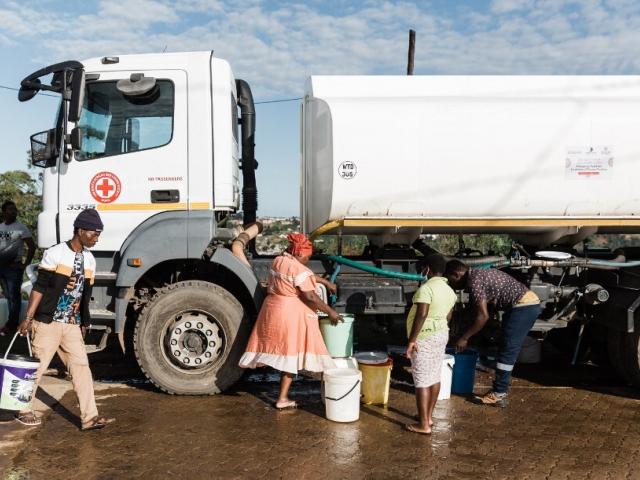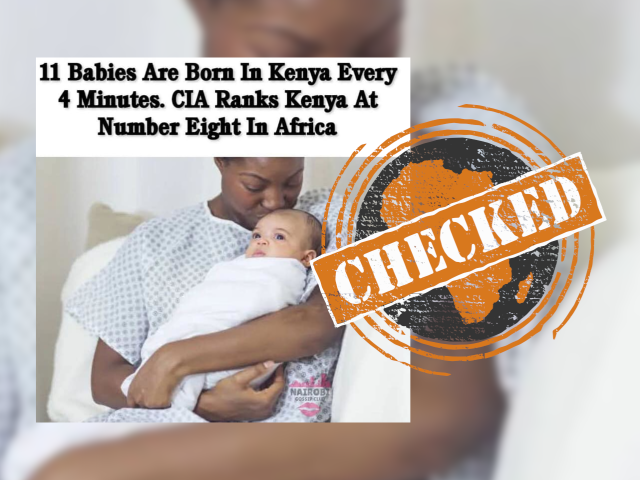This article is more than 6 years old
The vision of Nairobi’s new governor is “a clean, beautiful and healthy city where water is safe, accessible, affordable and regular”.
So governor Mike Sonko said at the opening of a water and sanitation workshop in January 2018. He is under pressure to solve a number of city problems, including crime, uncollected garbage, congestion and uncontrolled hawking.
We sieved the claims related to water supply in Sonko’s speech.
Africa Check asked Sonko’s communication team for the source of the claims in his speech. Speechwriter William Okoth referred us to the Nairobi City Water and Sewerage Company, though he did not say exactly which year’s numbers were used in the speech.
Non-revenue water refers to water that is placed in a water distribution system but not billed to customers, a World Bank technical advisory group explained. It has three components:
The Nairobi City Water and Sewerage Company is mandated to provide water and sewerage services to its owner, the Nairobi City county. The company’s most recent strategic plan shows that in the 2010/2011, 2011/2012 and 2012/2013 financial years, there was an increase in non-revenue water levels, at 37%, 39.5% and 39.8% respectively.
The strategic plan does not provide a figure for non-revenue water beyond the 2012/13 financial year. Africa Check has contacted the water company for the most recent figures, but has not yet received a response.
The government agency that regulates water and sewerage services in Kenya is the Water Services Regulatory Board.
The board’s annual reviews show that in 2013/2014, the Nairobi water company registered non-revenue water of 39%, while it was at 38% in 2014/15. The values for 2015/2016 and 2016/17 were 39.1% and 37.8%, Eric Njaggah, the director of technical services at the water regulatory board, told Africa Check.
The water regulatory board gives an acceptable non-revenue water threshold of 25%, and notes that losses are a serious problem in Kenya. One in every four of the country’s 66 urban water service providers actually lose more water than they sell.
There are a number of reasons for the high water losses, Njaggah said. These include old infrastructure, pipe leakages and bursts, theft and illegal connections. Meter under-registration - when a meter bills less than the water flowing through it - is also a challenge.
The Nairobi City Water and Sewerage Company has started projects to increase access to water, including a water dispenser in Mathare slum that allows residents to get water using a reloadable smart card for as low as KSh0.50 per 20 litres.
However, most people in Nairobi’s slums buy water from vendors who are close to where they live, community activists say.
Rachel Mwikali, an activist and resident of Mathare slum, told Africa Check that water is sourced from nearby Nairobi Water connections.
While there are some legal water points, Boniface Muthee, who chairs the Nairobi Water Action Groups, says much of the water sold in the slums is acquired illegally.
“These are people doing business outside the purview of Nairobi Water. They have done illegal connections and they are the ones controlling water supply in most of the slums in Nairobi,” he told Africa Check.
Media reports have documented the challenge of slum water supply, including the wide reach of cartels. This illegal trade is aided by the unplanned nature of the settlements, with ownership of the land on which they stand on often disputed.
Mwikali said in Mathare one can get water for between KSh2 and KSh5 per 20 l jerrycan.
Jane Anyango, who heads Polycom, a women’s grassroots group in Kibera, said these low water prices were only “when it is available”.
“But if it is not there - and in Kibera water is only available two to three times a week - and you have to go far, then it is KSh15 to KSh20,” she told Africa Check. “If they are bringing it for you using a mkokoteni [handcart], like when there is scarcity, it can go as high as KSh50.”
At KSh2 per 20 l jerrycan, slum dwellers pay KSh100 per m³, increasing to a massive KSh2,500 per m³ when the price is at KSh50 per jerrycan.
In comparison, residential customers of the Nairobi Water Company pay KSh204 for their first 6,000 l (KSh29.4 per m³), KSh53 for water use between 7,000 and 60,000 l and KSh64/m³ thereafter. Those living in flats or gated communities pay KSh53 per m³ for bulk supply.
Described as a “poverty penalty”, people in the slums do pay much more for water than those living in formal settlements, as Sonko claimed.
Further reading:
https://africacheck.org/factsheets/factsheet-cost-electricity-kenya/
https://africacheck.org/reports/many-sa-municipalities-lose-water-national-average-37-dont-know/
So governor Mike Sonko said at the opening of a water and sanitation workshop in January 2018. He is under pressure to solve a number of city problems, including crime, uncollected garbage, congestion and uncontrolled hawking.
We sieved the claims related to water supply in Sonko’s speech.
Africa Check asked Sonko’s communication team for the source of the claims in his speech. Speechwriter William Okoth referred us to the Nairobi City Water and Sewerage Company, though he did not say exactly which year’s numbers were used in the speech.
Non-revenue water refers to water that is placed in a water distribution system but not billed to customers, a World Bank technical advisory group explained. It has three components:
- water consumption that is unbilled for but authorised (such as for firefighting),
- commercial losses (including meter under-registration, unauthorised water use or billing errors),
- real or physical losses, which include leakages and tank overflows.
The Nairobi City Water and Sewerage Company is mandated to provide water and sewerage services to its owner, the Nairobi City county. The company’s most recent strategic plan shows that in the 2010/2011, 2011/2012 and 2012/2013 financial years, there was an increase in non-revenue water levels, at 37%, 39.5% and 39.8% respectively.
The strategic plan does not provide a figure for non-revenue water beyond the 2012/13 financial year. Africa Check has contacted the water company for the most recent figures, but has not yet received a response.
The government agency that regulates water and sewerage services in Kenya is the Water Services Regulatory Board.
The board’s annual reviews show that in 2013/2014, the Nairobi water company registered non-revenue water of 39%, while it was at 38% in 2014/15. The values for 2015/2016 and 2016/17 were 39.1% and 37.8%, Eric Njaggah, the director of technical services at the water regulatory board, told Africa Check.
The water regulatory board gives an acceptable non-revenue water threshold of 25%, and notes that losses are a serious problem in Kenya. One in every four of the country’s 66 urban water service providers actually lose more water than they sell.
There are a number of reasons for the high water losses, Njaggah said. These include old infrastructure, pipe leakages and bursts, theft and illegal connections. Meter under-registration - when a meter bills less than the water flowing through it - is also a challenge.
The Nairobi City Water and Sewerage Company has started projects to increase access to water, including a water dispenser in Mathare slum that allows residents to get water using a reloadable smart card for as low as KSh0.50 per 20 litres.
However, most people in Nairobi’s slums buy water from vendors who are close to where they live, community activists say.
Rachel Mwikali, an activist and resident of Mathare slum, told Africa Check that water is sourced from nearby Nairobi Water connections.
While there are some legal water points, Boniface Muthee, who chairs the Nairobi Water Action Groups, says much of the water sold in the slums is acquired illegally.
“These are people doing business outside the purview of Nairobi Water. They have done illegal connections and they are the ones controlling water supply in most of the slums in Nairobi,” he told Africa Check.
Media reports have documented the challenge of slum water supply, including the wide reach of cartels. This illegal trade is aided by the unplanned nature of the settlements, with ownership of the land on which they stand on often disputed.
Low water prices ‘only when it is available’
Mwikali said in Mathare one can get water for between KSh2 and KSh5 per 20 l jerrycan.
Jane Anyango, who heads Polycom, a women’s grassroots group in Kibera, said these low water prices were only “when it is available”.
“But if it is not there - and in Kibera water is only available two to three times a week - and you have to go far, then it is KSh15 to KSh20,” she told Africa Check. “If they are bringing it for you using a mkokoteni [handcart], like when there is scarcity, it can go as high as KSh50.”
At KSh2 per 20 l jerrycan, slum dwellers pay KSh100 per m³, increasing to a massive KSh2,500 per m³ when the price is at KSh50 per jerrycan.
In comparison, residential customers of the Nairobi Water Company pay KSh204 for their first 6,000 l (KSh29.4 per m³), KSh53 for water use between 7,000 and 60,000 l and KSh64/m³ thereafter. Those living in flats or gated communities pay KSh53 per m³ for bulk supply.
Described as a “poverty penalty”, people in the slums do pay much more for water than those living in formal settlements, as Sonko claimed.
Further reading:
https://africacheck.org/factsheets/factsheet-cost-electricity-kenya/
https://africacheck.org/reports/many-sa-municipalities-lose-water-national-average-37-dont-know/





Add new comment